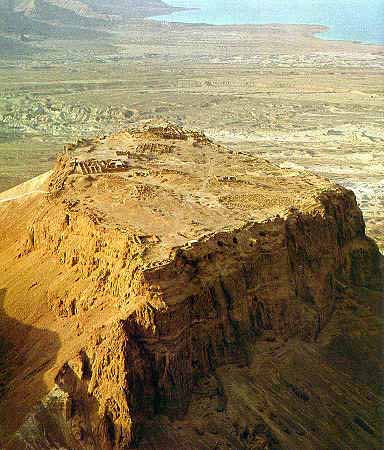Wadi Qumran and the Dead Sea Scrolls

In 1947 young Bedouin shepherds searching for a stray goat in the Judean Desert entered a long untouched cave and found jars filled with ancient scrolls. That initial discovery by the Bedouins yielded seven scrolls and began a search that lasted nearly a decade and eventually produced thousands of scroll fragments from eleven caves.
During those same years archaeologists searching for a habitation close to the caves that might help identify the people who deposited the scrolls excavated the Qumran ruin, a complex of structures located on a barren terrace between the cliffs where the caves are found and the Dead Sea. Within a fairly short time after their discovery, historical, paleographic, and linguistic evidence, as well as carbon-14 dating established that the scrolls and the Qumran ruin dated from the third century BC to 68 AD. They were indeed ancient! Coming from the late Second Temple Period, a time when Jesus of Nazareth lived, they are older than any other surviving biblical manuscripts by almost one thousand years ......
An Exhibit at the Library of Congress in Washington
The Dead Sea Region
Salt lake of Jordan -- Palestine -- Israel which is the lowest water surface on earth at minus 395 metres compared to the level of the Mediterranean Sea ..... The Dead Sea is geologically part of the Rift Valley system. The principal source of the Dead Sea is the Jordan River but there are other streams feeding it too ..... There is no outlet for the lake and evaporation leads to the high content of salt as it is about 6 times more salty than the ocean water. There is no life in the lake ..... Near the Dead Sea lies Qumran where the Dead Sea scrolls were found and the important Israeli national monument of Masada ...
Ancient Masada
One of the world's most startling natural fortifications, Masada is a majestic twenty three acre flat top mesa ten miles south of Ein Gedi and two and one half miles off the west shore of the Dead Sea. Its sides are composed of almost sheer rock cliffs a thousand feet above the barren Judean wilderness and 1300 feet above the waters of the Dead Sea. Being almost inaccessible and far removed from the usual travel routes it was first fortified by Jonathan the High Priest as a royal retreat during the second century BC when it was named Masada ..... In 40 BC Herod fled from Jerusalem to Masada with his family to escape from Mattathias Antigonus who had been made king by the Parthians. From Masada Herod traveled to Rome to seek help. The rock fortress proved its value on this occasion and after his return from Rome Herod chose Masada as his place of retreat and refuge in the event of possible attack by Cleopatra of Egypt; or in case the Jewish people should try to depose him and restore the former dynasty to power. As his royal abode he erected the Western Palace with storerooms for arms and provisions sufficient to supply ten thousand men for many years. Later to make his retreat doubly secure and more pleasant he moved his living quarters to the northern precipice where he erected his three-tiered hanging palace ...
After Herod's death in 4 BC a Roman garrison was stationed at Masada and this occupation continued until AD 66 when a large-scale Jewish revolt broke out all over the land. At this time the Jews made a lightning raid on Masada and displaced the Romans. As fighting continued throughout Palestine many more zealous Jews came to Masada and strengthened their garrison. After the fall of Jerusalem under Titus in AD 70 the few surviving Jews who had evaded capture made their way across the Judean wilderness to Masada and joined the patriots in their determination to continue the battle for freedom. In the autumn of AD 72 Flavius Silva -- the Roman general -- took his Tenth Legion, its auxiliary troops and thousands of Jewish prisoners of war and laid siege to Masada; which was then defended by Eleazar, leader of the Zealots. For long months the patriots defended themselves but when the Romans eventually completed an enormous earthen ramp to the top, placed battering rams against the walls and set fire to the fortification the defenders saw they could resist no more ..... On April 15 AD 73 when the Romans at last got into the fortress they found alive only two women and five children -- who had concealed themselves -- and a mass of 960 dead bodies. When the Tenth Legion broke camp and marched back to Jerusalem a small guard remained at the fortress for some years after. Masada returned to ruins during the following nineteen centuries ....



No comments:
Post a Comment